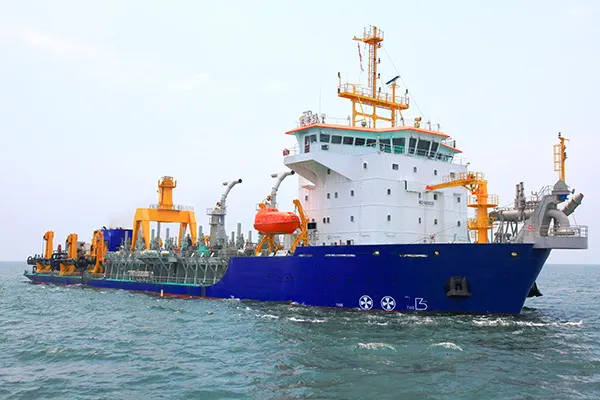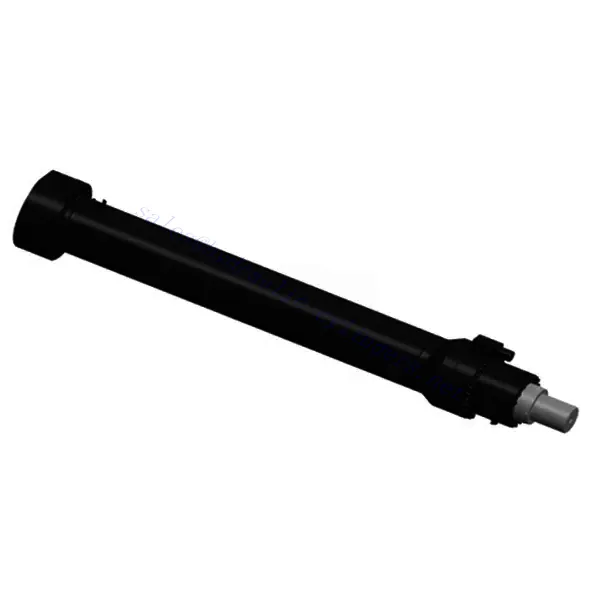Trailing Suction Dredger Heave Compensation Cylinder
Como um dos fabricantes, fornecedores e exportadores de produtos mecânicos de cilindros hidráulicos, oferecemos cilindros hidráulicos e muitos outros produtos.
Entre em contato conosco para obter detalhes.
Correio eletrônico:sales@hydraulic-cylinders.net
Fabricante, fornecedor e exportador de cilindros hidráulicos.
Trailing Suction Dredger Heave Compensation Cylinder

The trailing suction dredger heave compensation cylinder is a cutting-edge hydraulic device that has revolutionized the efficiency and effectiveness of dredging operations. Designed to provide precise heave compensation, this cylinder ensures optimal dredging performance even in challenging marine environments.
The trailing suction dredger heave compensation cylinder is a game-changer in the field of marine dredging. Its heavy compensation capability, robust construction, and high-precision control contribute to enhanced efficiency and accuracy in dredging operations. By following proper usage methods and adopting a proactive maintenance approach, marine professionals can maximize the performance and lifespan of this exceptional hydraulic device. Embrace the power of the trailing suction dredger heave compensation cylinder and experience the difference it can make in your dredging endeavors.
Trailing Suction Dredger Heave Compensation Cylinder Key Characteristics:
- Heave Compensation Capability: The trailing suction dredger heave compensation cylinder is specifically engineered to counteract the effects of vessel heave during dredging operations. It effectively compensates for vertical movements, allowing consistent and accurate suction pipe positioning.
- Robust Construction: Built with durability in mind, this cylinder is crafted from high-quality materials that offer exceptional strength and resistance to corrosion. It can withstand harsh marine conditions, ensuring long-lasting performance and reliability.
- High-Precision Control: The cylinder’s advanced hydraulic system enables precise control over the heave compensation process. It allows for responsive adjustments, ensuring the suction pipe maintains the desired depth and position for efficient dredging.
Trailing Suction Dredger Heave Compensation Cylinder Parameter:
| Product Name | Trailing Suction Dredger Heave Compensation Cylinder |
| Features: | Compensate the relative displacement of the drag head and the hull when working |
| Bore diameter: | Up to 400mm |
| Rod diameter: | Up to 360mm Stroke up to 4000mm |
| Pressure: | up to 32MPa |
| Thrust force: | Maximum 1600KN |
| Applications: | Trailing Suction Dredger |
Rod diameter: up to 360mm
Stroke up to 5200mm
Dredger Tank Cutter-Suction Cylinders Application:

Usage Method Of Trailing Suction Dredger Heave Compensation Cylinder:
- Preparation: Conduct a thorough inspection before using the trailing suction dredger heave compensation cylinder to ensure all components are properly working. Check for any signs of damage, leaks, or worn-out seals.
- Installation: Mount the cylinder securely to the dredger or related equipment, ensuring stability during operation. Follow the manufacturer’s guidelines for proper installation, including the alignment of hydraulic connections.
- Hydraulic System Integration: Connect the cylinder to the hydraulic power source using compatible hoses or fittings. Verify that the connections are tight, leak-free, and properly aligned.
- Calibration: Calibrate the heave compensation system according to the specific dredging requirements. This may involve adjusting parameters such as stroke length, speed, or pressure. Refer to the manufacturer’s instructions for precise calibration methods.
- Operational Control: Activate the hydraulic power source to initiate the heave compensation process. The trailing suction dredger heave compensation cylinder will automatically respond to vessel heave, maintaining the desired suction pipe position for efficient dredging. Monitor the operation closely for optimal results.
How Does A Double Acting Hydraulic Cylinder Work?
A double-acting hydraulic cylinder is a type of hydraulic actuator that operates in both directions, providing force and motion in both the extension and retraction strokes. It consists of a cylindrical barrel, a piston, piston rods, seals, and ports for hydraulic fluid.
Here is a step-by-step breakdown of how a double-acting hydraulic cylinder works:
- Fluid Intake: The hydraulic cylinder is connected to a hydraulic power unit or pump supplying pressurized hydraulic fluid. The fluid is typically an oil-based hydraulic fluid.
- Extension Stroke: When hydraulic fluid is supplied to the cylinder’s rod-end port, it enters the cylinder’s barrel behind the piston. The fluid’s pressure pushes the piston and the connected piston rod outward, extending the cylinder.
- Retraction Stroke: To retract the cylinder, hydraulic fluid is supplied to the cylinder’s cap-end port. The fluid enters the barrel in front of the piston, exerting pressure and pushing the piston and piston rod back into the cylinder.
- Mecanismo de vedação: The hydraulic cylinder is equipped with seals, such as piston seals and rod seals, which prevent hydraulic fluid leakage. These seals ensure the fluid is contained within the cylinder, maintaining the pressure and preventing force loss.
- Control Valves: Control valves are used to control the direction and flow of hydraulic fluid. These valves direct the fluid to the appropriate port of the cylinder, allowing for extension or retraction based on the desired motion.
- Piston and Rod Design: The piston and piston rod are typically sealed off from each other to ensure that the pressurized fluid only acts on one side of the piston at a time. This design allows for separate extension and retraction strokes, providing bidirectional movement.
- Load Application: The piston rod of the hydraulic cylinder is attached to the load or the mechanism that requires force or motion. As the hydraulic fluid extends or retracts the piston, the power generated is transferred through the piston rod to the load, enabling it to move or exert force.
- Pressure Relief: To control the speed and force of the hydraulic cylinder, pressure relief valves or flow control valves may be used in the hydraulic system. These valves regulate the pressure and flow of hydraulic fluid, preventing excessive pressure buildup and ensuring safe operation.
Aptidão e capacidade da fábrica:
(1) Montagem
Temos uma plataforma de montagem de pesquisa e desenvolvimento independente de primeira classe. A oficina de produção de cilindros hidráulicos tem quatro linhas de montagem semiautomáticas de cilindros de elevação e uma linha de montagem automática de cilindros de inclinação, com uma capacidade de produção anual projetada de 1 milhão de peças. A oficina de cilindros especiais é equipada com várias especificações de um sistema de montagem de limpeza semiautomática com uma capacidade de produção anual projetada de 200.000 peças e equipada com famosos equipamentos de usinagem CNC, um centro de usinagem, um equipamento especial de processamento de cilindros de alta precisão, uma máquina de solda robotizada, uma máquina de limpeza automática, uma máquina de montagem automática de cilindros e uma linha de produção de pintura automática. O equipamento crítico existente é de mais de 300 conjuntos (conjuntos). A alocação ideal e o uso eficiente dos recursos do equipamento garantem os requisitos de precisão dos produtos e atendem às necessidades de alta qualidade dos produtos.


(2) Usinagem
A oficina de usinagem é equipada com um centro de torneamento de trilho inclinado personalizado, um centro de usinagem, uma máquina de brunimento de alta velocidade, um robô de soldagem e outros equipamentos relacionados, que podem lidar com o processamento de tubos de cilindros com diâmetro interno máximo de 400 mm e comprimento máximo de 6 metros.

(3) Soldagem

(4) Pintura e revestimento
Com linhas de revestimento de tinta à base de água automáticas de cilindros de pequeno e médio porte, para obter carregamento e descarregamento automáticos de robôs e pulverização automática, a capacidade projetada é de 4.000 peças por turno;
Também temos uma linha de produção de tinta semiautomática para cilindros grandes, acionada por uma corrente elétrica, com capacidade de projeto de 60 caixas por turno.


(5) Testes
Temos instalações de inspeção e bancos de teste de primeira classe para garantir que o desempenho do cilindro atenda aos requisitos.

We are one of the best hydraulic cylinder manufacturers. We can offer comprehensive hydraulic cylinders. We also provide corresponding caixas de câmbio agrícolas. Exportamos nossos produtos para clientes em todo o mundo e conquistamos uma boa reputação devido à qualidade superior de nossos produtos e ao serviço pós-venda. Convidamos clientes nacionais e estrangeiros a entrar em contato conosco para negociar negócios, trocar informações e cooperar conosco!
Faça um tour pela nossa fábrica de RV:
Faça um tour pela nossa fábrica de RV com o seguinte
Como funciona o cilindro hidráulico da empilhadeira?
Cilindro hidráulico Aplicação:


